MaryAnn Bernal's Blog, page 293
April 13, 2014
Archeologists' findings may prove Rome a century older than thought
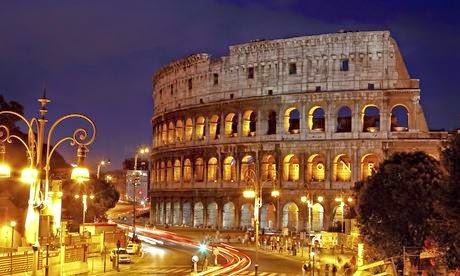 Rome may be older than its official birthday of 21 April 753BC when founded by Romulus and Remus. Photograph: WestEnd61/Rex
Rome may be older than its official birthday of 21 April 753BC when founded by Romulus and Remus. Photograph: WestEnd61/RexJohn Hooper in Rome
It is already known as the eternal city, and if new archeological findings prove correct Rome may turn out to be even more so than believed until now.
Next week, the city will celebrate its official, 2,767th birthday. According to a tradition going back to classic times, the brothers Romulus and Remus founded the city on 21 April in the year 753BC.
But on Sundayit was reported that evidence of infrastructure building had been found, dating from more than 100 years earlier. The daily Il Messagero quoted Patrizia Fortini, the archaeologist responsible for the Forum, as saying that a wall constructed well before the city's traditional founding date had been unearthed.
The wall, made from blocks of volcanic tuff, appeared to have been built to channel water from an aquifer under the Capitoline hill that flows into the river Spino, a tributary of the Tiber. Around the wall, archaeologists found pieces of ceramic pottery and remains of food.
"The examination of the ceramic material was crucial, allowing us today to fix the wall chronologically between the 9th century and the beginning of the 8th century," said Fortini.
It was already known that the settlement of Rome was a gradual process and that the traditional date for its foundation was invented by a later writer. There is evidence of people arriving on the Palatine hill as early as the 10th century BC.
The find would appear to show that construction in stone began earlier than previously established. The discovery was made close to the Lapis Niger ('Black Stone' in Latin): a shrine that later Romans associated with their city's earliest days. The site includes a stone block that carries the earliest inscription found in Rome. Written in the 5th century BC, its meaning is not fully clear, but it is thought to place a curse on anyone who violates the site.
• The standirst on this article was amended on 13 April to reflect the correct date of Rome's founding
http://www.theguardian.com/world/2014/apr/13/archaelogists-find-rome-century-older-than-thought

Published on April 13, 2014 13:01
16th-Century Masterpiece Reveals Cheese Glue Recipe
 by Rossella Lorenzi
by Rossella Lorenzi Sticky cheese might be the secret behind one of the most intriguing Mannerist paintings, according to a preliminary investigation carried out during restoration work.
Restorers had wondered what holds together the five poplar wood planks which make up “Visitation,” an enigmatic work by the 16th-century Mannerist Jacopo Pontormo.
“We believe they were pieced together with a caseine-based glue,” restorer Daniele Rossi told Discovery News. Caseine is a group of proteins commonly found in mammalian milk.
Photos: Restoring ‘Visitation’
“Cheese glue was very popular at that time, and was normally used to join wood planks. We are going to carry out special chemical analyses for bindings to get a definitive answer,” Rossi said.
Described in the 16th-century Compendium of Rational Secrets as a “great secret of nature, a “super glue which withstands dampness and heat,” cheese glue was already detailed in the artists’ manuals of both Theophilus, a 12th-century German monk and 15th-century Italian painter Cennino Cennini.
The recipe for the potent adhesive relied on polypeptide casein protein molecules, and included ingredients such as hot water and quicklime. The goat or cow cheese-based concoction resulted in a sticky and thick compound which dried hard as stone, making it extremely hard for wood joints to separate.
Photos: Da Vinci’s ‘Magi’ Hides Master’s Original Vision
“Whatever glue was used there, it was a powerful one. It’s still holding after five centuries,” Rossi said.
The source of inspiration for “The Greeting,” a video installation presented at the 1995 Venice Biennial by the Italian American artist Bill Viola, the dream-like Visitation is now the centerpiece of an exhibition on Mannerist artists Jacopo Carucci, also known as Pontormo (1494-1557), and Giovan Battista di Jacopo, a.k.a. Rosso Fiorentino (1494-1540) which runs in Florence through July 20.
Pontormo was one of the last artists of the Florentine Renaissance. He was a pupil of Leonardo da Vinci and Andrea del Sarto, and one of the earliest of the Mannerist school, a style of art developed in Italy following the High Renaissance, which emphasized mental conception over realistic depiction.
Pontormo completed the Visitation around 1528-1529, but the oil painting remained almost unknown until 1904, when it was rediscovered in the church of San Michele in Carmignano, a village west of Florence, and attributed to Pontormo.
Michelangelo’s David Holding Secret Weapon?
The painting depicts in an almost metaphysical way the biblical meeting of the Virgin Mary, pregnant with Jesus, and Elisabeth, pregnant with St. John the Baptist. Staring fixedly into space, two statuesque figures in the background represent their alter egos.
The younger of the two wears the same color clothing of the Virgin Mary, but reversed. The older one appears to be Elizabeth shown in a sort of doubling.
Naked Dwarf Revealed Again in Painting
“This intensely abstract atmosphere is sustained by the disproportionate size of the figures in comparison to the Florentine architectural backdrop and by the artist’s multiplication – as though in a mirror – of the number of figures witnessing the scene,” art critic Antonio Geremicca wrote in the exhibition catalog.
“These figurative devices make it more complicated to interpret the painting, whose significance scholars have yet to fathom in full,” he added.
Rossi’s restoration might help acquire new clues.
In addition to finding the super glue, the restorer filled 1,673 woodworm holes and removed the heavy repainting of past restorations. Incisive, luminous colors which previous interventions covered with a yellow varnish, re-emerged in full glory.
Photos: The Face of Da Vinci: An Enduring Mystery
“We discovered a bright blue sky beneath a black overpainting that had made it almost overcast, and Pontormo’s clouds are white and ragged,” Rossi said.
Previously unseen details were also unveiled.
“A woman is leaning out of a window and a white cloth is falling from a window ledge. A smiling donkey peeks out from behind the corner of a building, while two passers-by converse on a bench like masked mannequins,” Rossi said.
Image: Detail of The Visitation by Jacopo Pontormo. Credit: Daniele Rossihttp://news.discovery.com/history/art-history/16th-century-masterpiece-reveals-cheese-glue-recipe-140326.htm

Published on April 13, 2014 12:55
Medieval Poop Found: Still Stinks
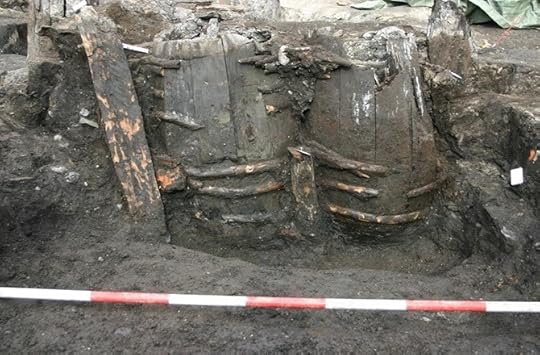
by Rossella Lorenzi
A number of Medieval wooden barrels have been uncovered in Denmark, revealing their less- than-glamorous contents.
Originally built to transport goods and store fish, the barrels were converted into latrines — still filled with their original contents.
"We are talking about 700-year-old latrines. And yes, they still smell bad," Maria Elisabeth Lauridsen, the archaeologist in charge of the excavation, told Discovery News.
Photos: Digging Up a Medieval Latrine
Unearthed in the center of the Medieval town of Odense, the birthplace of the fairy tale writer Hans Christian Andersen, the barrels are believed to have served a toilet area.
"The excavation is characterized by great conditions for preservation and is located on a Medieval site that has been found to contain brick houses, half-timbered houses and stables," Lauridsen said.
Described as being in "excellent condition," the human excrement can give scientists unique insight into what people ate in Denmark in the Middle Ages.
Photos: Top 10 Things Poop Makes Better
"Preliminary results of analysis show that raspberries were popular in Odense in the 1300s. The contents also contain small pieces of moss, leather and fabric which were used as toilet paper," Lauridsen said.
It appears that barrels were recycled for various use in Medieval Odense. The excavation unearthed three barrels stacked on top of one another and tied together that served as a basic well.
Poop Gets Its Close-Up
A system of pipes at the bottom of the structure led water to the well. To prevent mud from getting into the well, the lowest barrel was covered with reeds.
"This well has probably been a part of beer brewing. We have excavated nearby a stock of partially germinated barley which is commonly used in the brewing process," Lauridsen said.
Video: What's in Your Poop?
Visitors can go on a free tour of the excavation every Tuesday and Thursday at 1:00 pm and can visit the archaeologists' workshop every Tuesday, Wednesday and Thursday from noon to 3:00.
"We are finding new and exciting information about the life that was lived in Odense during the 14th century," Lauridsen said.
Image: Human excrement still smelling bad has been found in these 700 year old barrel latrines. Credit: Odense City Museum.
http://news.discovery.com/history/archaeology/medieval-poop-still-smelling-bad-found-140401.htm

Published on April 13, 2014 12:49
History Trivia - Constantinople falls
April 13
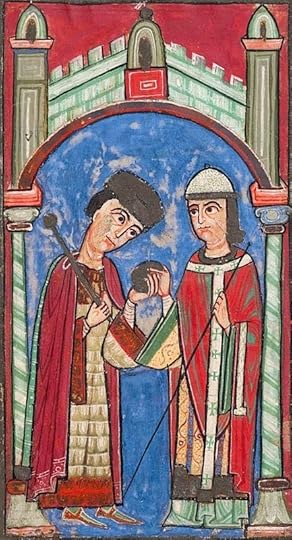
1111 Henry V was crowned Holy Roman Emperor.
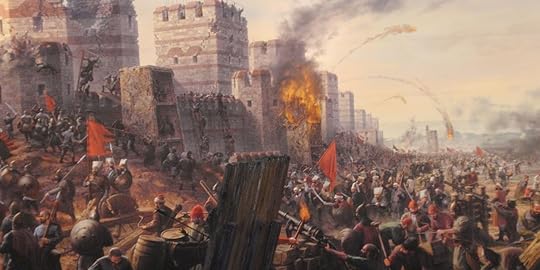
1204 Constantinople fell to the Crusaders of the Fourth Crusade, temporarily ending the Byzantine Empire.
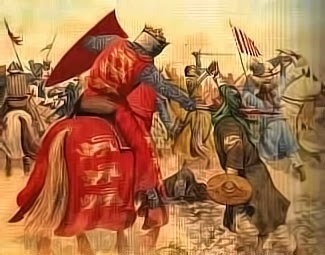
1250 The Seventh Crusade was defeated in Egypt; Louis IX of France was captured.
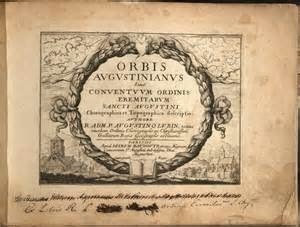
1256 The Grand Union of the Augustinian order formed when Pope Alexander IV issues a papal bull Licet ecclesiae catholicae.
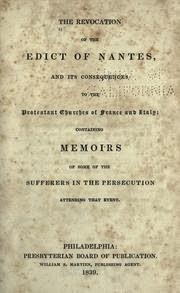
1598 Henry IV of France issued the Edict of Nantes, allowing freedom of religion to the Huguenots. (Edict repealed in 1685.)
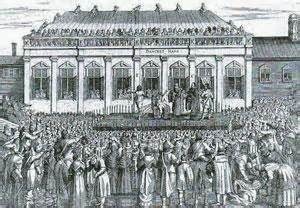
1640 Charles I's eleven years of personal rule end with the calling of the 'Short Parliament' at Westminster.


1111 Henry V was crowned Holy Roman Emperor.

1204 Constantinople fell to the Crusaders of the Fourth Crusade, temporarily ending the Byzantine Empire.

1250 The Seventh Crusade was defeated in Egypt; Louis IX of France was captured.

1256 The Grand Union of the Augustinian order formed when Pope Alexander IV issues a papal bull Licet ecclesiae catholicae.

1598 Henry IV of France issued the Edict of Nantes, allowing freedom of religion to the Huguenots. (Edict repealed in 1685.)

1640 Charles I's eleven years of personal rule end with the calling of the 'Short Parliament' at Westminster.

Published on April 13, 2014 03:56
April 12, 2014
Congratulations Bill Jones, Jr. - Authorsdb #1

Authors Directory Bill Jones, Jr.
Bill Jones, Jr.
 Hot http://photos.authorsdb.com/thumbnail...
Hot http://photos.authorsdb.com/thumbnail...Written by Bill Jones, Jr. December 23, 2013 0 1 0 0 Comments (0) Add to favorites
 Author DetailsBloghttp://thisblogblank.wordpress.comTwitter@billjonesjrFacebook PageLike My PageLinkedInConnect With MeMy PinterestRepin & Follow MeAuthorGraphGet My AutographBioBill Jones, Jr. was born in Washington, D.C. and grew up as a painfully shy kid in southern Virginia, listening to his mother’s war stories and wondering why he didn’t inherit her gift for storytelling. Some years later, after discovering he had a talent for writing poetry, Bill thought perhaps not all of Mom’s genetics went to waste. In 2008, a writer friend encouraged him to pen a short story. He loved it. Shortly thereafter, he decided to see if he could turn the story into a book. It became two: Discovery and Awakening, the first two books of his fantasy fiction series The Stream.
Author DetailsBloghttp://thisblogblank.wordpress.comTwitter@billjonesjrFacebook PageLike My PageLinkedInConnect With MeMy PinterestRepin & Follow MeAuthorGraphGet My AutographBioBill Jones, Jr. was born in Washington, D.C. and grew up as a painfully shy kid in southern Virginia, listening to his mother’s war stories and wondering why he didn’t inherit her gift for storytelling. Some years later, after discovering he had a talent for writing poetry, Bill thought perhaps not all of Mom’s genetics went to waste. In 2008, a writer friend encouraged him to pen a short story. He loved it. Shortly thereafter, he decided to see if he could turn the story into a book. It became two: Discovery and Awakening, the first two books of his fantasy fiction series The Stream.Since then, he’s been writing almost constantly. He finished The Stream trilogy with Emprise, and then went on to write a short story anthology, The Juice and Other Stories, as well as his first Sci-Fi novel, Hard as Roxx. Currently, he’s editing a detective novel, has another in progress, and has begun a second short story collection.
On those rare days he’s not working at his Lockheed Martin day job, or his writing night job, Bill is a photographer, father, and life coach, along with other things he does for love rather than money. Usually, however, Bill can be found somewhere under a camera, shooting whatever there is. On the very best days, his photos end up as a scene in a book. On his bad days, they still end up as an scene in a book – just an angry one.Where I LiveGermantown, Maryland, USABadges

 GenreTypeFictionFiction Action & AdventureFantasyMystery & DetectiveScience FictionShort StoriesBook DetailsMy Amazon Book ListAmazon Book Descriptions, Reviews & BuyAuthor of science fiction, adventure, and mystery novels, including the acclaimed series, The Stream. http://authorsdb.com/authors-directory/6284-bill-jones-jr
GenreTypeFictionFiction Action & AdventureFantasyMystery & DetectiveScience FictionShort StoriesBook DetailsMy Amazon Book ListAmazon Book Descriptions, Reviews & BuyAuthor of science fiction, adventure, and mystery novels, including the acclaimed series, The Stream. http://authorsdb.com/authors-directory/6284-bill-jones-jr

Published on April 12, 2014 04:41
History Trivia - Crusaders of the Fourth Crusade breach the walls of Constantinople
April 12
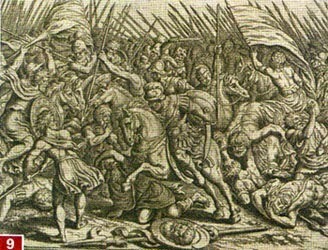
238 Gordian II lost the Battle of Carthage against the Numidian forces loyal to Maximinus Thrax and was killed. Gordian I, his father, committed suicide.
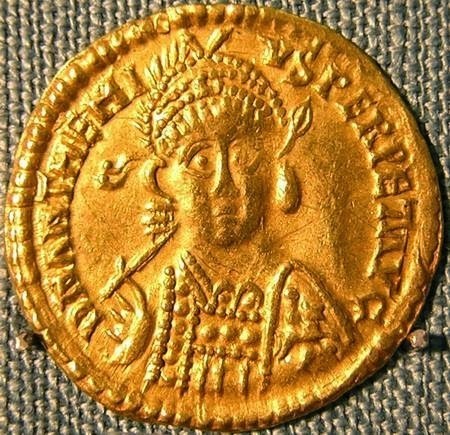
467 Anthemius was elevated to Emperor of the Western Roman Empire.
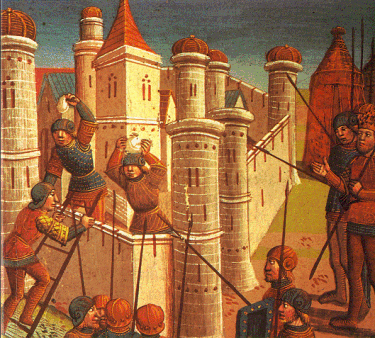
1204 The Crusaders of the Fourth Crusade breached the walls of Constantinople and entered the city, which they completely occupied the following day.

1606 The combined English-Scottish 'Union Jack' was created by royal decree, originally for use at sea only.


238 Gordian II lost the Battle of Carthage against the Numidian forces loyal to Maximinus Thrax and was killed. Gordian I, his father, committed suicide.

467 Anthemius was elevated to Emperor of the Western Roman Empire.

1204 The Crusaders of the Fourth Crusade breached the walls of Constantinople and entered the city, which they completely occupied the following day.

1606 The combined English-Scottish 'Union Jack' was created by royal decree, originally for use at sea only.

Published on April 12, 2014 04:26
April 11, 2014
Fun Facts about author K. Meador - stuff you didn't know

What you don't know about author K. Meador:
- her favorite cartoons are Bugs Bunny and Scooby Doo - her favorite color is green- her other profession is being an aircraft mechanic- as a mechanic she has blown down a fence while running aircraft engines- as a mechanic she has worked for the customs and border patrol in Texas and saw drug lords unloaded from one aircraft to another in shackles and chains accompanied by guards with high power guns. - as a mechanic at the customs and border patrol in Texas, she has watched untold amount of confiscated drugs moved from one aircraft to another under heavy guard. - boarded a pirate ship in Savannah Georgia that was rebuilt and sailed 10 months of the year- spent three months on the island of Oahu, Hawaii (all bills paid)
Visit Ms. Meador's webpage:
www.authorkmeador.com


Published on April 11, 2014 13:56
Diane Turner - London Rocks - 11.04.2014
Published on April 11, 2014 13:53
Titanic Sunk During Average Iceberg Year
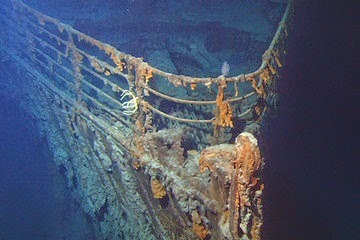 Built in Northern Ireland in 1909, the "RMS Titanic" was also known as the "unsinkable ship," because it had a double-bottom hull divided into 16 compartments that were presumed to be watertight. The 882.5-foot-long (268.9 meters) craft sank in April 1912 after it struck an iceberg off southern Newfoundland, and now rests on the ocean floor at a depth of 12,460 feet (3.7 kilometers).
Built in Northern Ireland in 1909, the "RMS Titanic" was also known as the "unsinkable ship," because it had a double-bottom hull divided into 16 compartments that were presumed to be watertight. The 882.5-foot-long (268.9 meters) craft sank in April 1912 after it struck an iceberg off southern Newfoundland, and now rests on the ocean floor at a depth of 12,460 feet (3.7 kilometers).Credit: NOAA | Institute for Exploration | University of Rhode Island By Becky Oskin, Senior Writer
Old Coast Guard records are throwing cold water on a long-standing explanation for the loss of the Titanic: the suggestion that the fateful journey took place in waters bristling with icebergs, making 1912 an unlucky year to sail the North Atlantic.
Instead, more than a century of Atlantic iceberg counts reveals 1912 was an average year for dangerous floating ice. The findings also contradict a popular notion that the Jakobshavn Isbrae glacier on Greenland's west coast birthed the Titanic's deadly 'berg. Instead, a computer model suggests that one of the glaciers at Greenland's southern tip released the iceberg that hit the Titanic on April 14, 1912, drowning more than 1,500 people in the frigid ocean.
"I think the question of whether this was an unusual year has been laid to rest," said Grant Bigg, an environmental scientist at the University of Sheffield and lead study author, adding, "1912 is not an exceptional year."
After a glancing collision with an estimated 325-foot (100 meters) wide iceberg on April 14 of that year, the Titanic broke into two pieces and sank. In the decades since, the tragedy has acquired a vast history and mythology as people seek to account for the loss of the "unsinkable" ship on its maiden voyage.
For example, many Titanic theorists have said that 1912 was an exceptional iceberg year. Explanations for the purported abundance of icebergs have ranged from a warm 1912 winter, to sunspots, to high tides from a 1912 'supermoon,' which could have dislodged icebergs.
But the new findings contradict these earlier theories. "This really refutes the arguments that have been around about things like high tides or sunspots generating excessive numbers of icebergs in that year," Bigg told Live Science. [Video: How the Titanic Sank]
The research was published today (April 10) in the journal Weather.
Floating floes
The new results come from a broader examination of Greenland icebergs by Bigg and study co-author David Wilton, also from the University of Sheffield. The researchers are tracking icebergs over time to test Greenland's response to climate change and the contribution to sea level rise from icebergs. They are studying data collected by the U.S. Coast Guard's International Ice Patrol extending back to 1900.
According to Bigg, 1912 was a high ice year, but not exceptional compared with the surrounding decades.
In 1912, data shows that 1,038 icebergs moved south from Arctic waters, and crossed the 48th parallel. The Coast Guard records show a slightly higher number of 1,041 icebergs crossed south of 48 degrees north in 1909. Between 1901 and 1920, five years saw at least 700 icebergs drift below 48 degrees north, where they could menace ships.
Bigg said the broader study indicates climate change has increased the risk of icebergs for ships sailing near Greenland in recent decades. Between 1991 and 2000, five years saw more icebergs below the 48th parallel than in 1912. "The values are now twice as high as the largest values from earlier in the century," Bigg said. "Greenland's contribution to sea level rise is increasing."
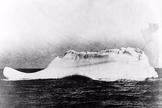 [image error]
[image error]
 A purported photo of the iceberg that sank the Titanic.
A purported photo of the iceberg that sank the Titanic.Credit: U.S. Coast Guard Historian's OfficeView full size imageBirth of a tragedy
Bigg and Wilton also created a computer model to plot the likely path of icebergs discharged from Greenland's glaciers. The model showed that the deadly 1912 iceberg probably originated from southern Greenland in late summer or early autumn of 1911. This 'berg likely sailed directly southwest toward southern Labrador and Newfoundland, rather than heading north up the Greenland coast into Baffin Bay and circling around via the Labrador Current, as other models have suggested, Bigg said.
The iceberg was originally 1,640 feet (500 m) wide and 985 feet (300 m) high, the model indicates. By April, the floating chunk was just 325-foot (100 meters) wide.
"It still looked large to the people on the ship, but it had melted quite a bit," Bigg said.
http://www.livescience.com/44754-titanic-1912-iceberg-theory-challenged.html

Published on April 11, 2014 13:49
Tests Suggest 'Gospel of Jesus' Wife' Is Authentic
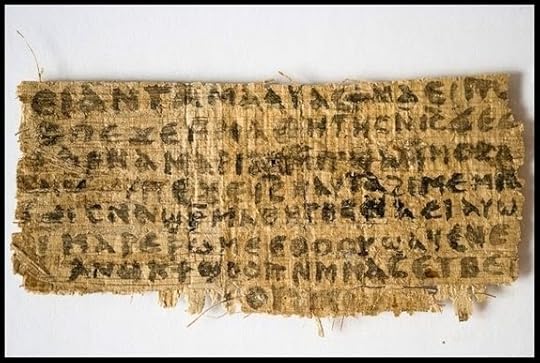 http://www.livescience.com/44748-gospel-of-jesus-wife-authentic.htmlA newly discovered scrap of 4th-century papyrus containing a reference to Jesus' wife.
http://www.livescience.com/44748-gospel-of-jesus-wife-authentic.htmlA newly discovered scrap of 4th-century papyrus containing a reference to Jesus' wife.Credit: © Karen L. King 2012
A small scrap of brown papyrus paper, about the size of a business card, has ignited a red-hot argument that spans all of Christendom.
The papyrus document, known as the "Gospel of Jesus' Wife," was unveiled in 2012 and instantly set off a debate over its authenticity. Perhaps its most controversial elements are lines that suggest Jesus had a wife.
But a recent announcement from the Harvard Divinity School that the document is probably genuine has rekindled the disagreement over its provenance and meaning. [Religious Mysteries: 8 Alleged Relics of Jesus]
In one segment of the papyrus's text, the words "Jesus said to them, 'My wife...'" appear in a crude, hand-lettered Coptic script. (Coptic is an ancient language used by Christians living in Egypt.)
In another segment, the words "she will be able to be my disciple" have led some to argue that Jesus was promoting a woman to hold a position in the early Christian church — a controversial position then as now.
The existence of the papyrus document was first announced in 2012 by Karen L. King, a historian of early Christianity and a professor of divinity at Harvard Divinity School. King first examined the privately owned fragment in 2011, and has since been studying it with a group of biblical scholars.
But is it real?
Since its discovery, the document has been dismissed as a forgery by some historians. "It is very probable that it's a fake," Christian Askeland, a Coptic scholar based in Germany, said in a widely disseminated YouTube video.
First, the writing is sloppy, according to Askeland. Compared with authentic Coptic papyri, in which letters are written with varying thickness and subtle curves and details, the letters in the Gospel of Jesus' Wife are formed by rigid, straight strokes of equal thickness.
Some experts have also noted that the scribe does not seem to have used either of the writing instruments common to the time period: a stylus (Roman metal pen) or a calamus (Egyptian reed pen). Additionally, the textual content raises questions, because even though much of the manuscript's text is cut off, its meaning is "too easy" to decipher, Askeland said.
No evidence of fraud
Further testing of the papyrus, the ink, the handwriting and the grammar, however, all point to the document's authenticity, according to a recent statement from the Harvard Divinity School.
A technique called micro-Raman spectroscopy, which measures the scattering of light from a sample, revealed that the carbon in the ink matched samples of other papyrus documents that date from the first to eighth centuries A.D.
"The main thing was to see, did somebody doctor this up?" Timothy M. Swager, a chemistry professor at the Massachusetts Institute of Technology, told The New York Times. "And there is absolutely no evidence for that. It would have been extremely difficult, if not impossible."
Swager used infrared spectroscopy, which analyzes the low-frequency light from an object, to see if the ink showed any inconsistencies or variations that would suggest it was a recent forgery. None were found.
A "Monty Python" sketch?
Not all skeptics, however, are dissuaded by these recent findings. Leo Depuydt, a professor of Egyptology at Brown University, said in a statement in the Harvard Theological Review that the fragment is so obviously fake that it "seems ripe for a 'Monty Python' sketch."
The papyrus also contains "gross grammatical errors," Depuydt said, adding that "an undergraduate student with one semester of Coptic can make a reed pen and start drawing lines."
Nonetheless, the document has renewed questions about the role of women and married men in the church — in both ancient and modern times.
"This gospel fragment provides a reason to reconsider what we thought we knew by asking what the role claims of Jesus' marital status played historically in early Christian controversies over marriage, celibacy and family," King said in a statement.

Published on April 11, 2014 13:42




